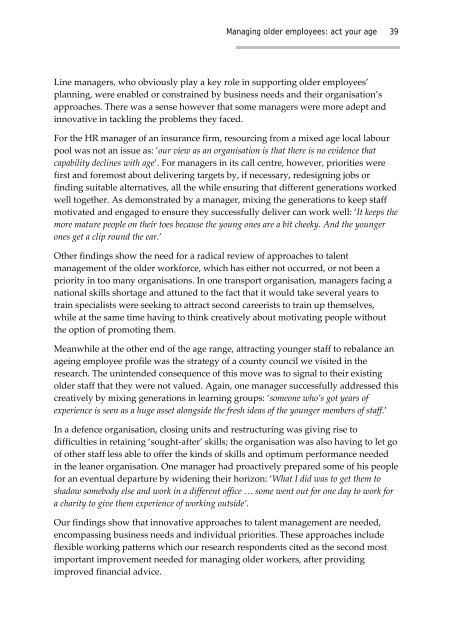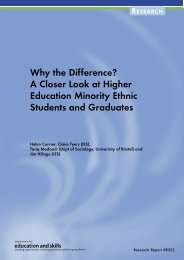PDF of this item - The Institute for Employment Studies
PDF of this item - The Institute for Employment Studies
PDF of this item - The Institute for Employment Studies
- No tags were found...
Create successful ePaper yourself
Turn your PDF publications into a flip-book with our unique Google optimized e-Paper software.
Managing older employees: act your age 39Line managers, who obviously play a key role in supporting older employees’planning, were enabled or constrained by business needs and their organisation’sapproaches. <strong>The</strong>re was a sense however that some managers were more adept andinnovative in tackling the problems they faced.For the HR manager <strong>of</strong> an insurance firm, resourcing from a mixed age local labourpool was not an issue as: ’our view as an organisation is that there is no evidence thatcapability declines with age’. For managers in its call centre, however, priorities werefirst and <strong>for</strong>emost about delivering targets by, if necessary, redesigning jobs orfinding suitable alternatives, all the while ensuring that different generations workedwell together. As demonstrated by a manager, mixing the generations to keep staffmotivated and engaged to ensure they successfully deliver can work well: ‘It keeps themore mature people on their toes because the young ones are a bit cheeky. And the youngerones get a clip round the ear.’Other findings show the need <strong>for</strong> a radical review <strong>of</strong> approaches to talentmanagement <strong>of</strong> the older work<strong>for</strong>ce, which has either not occurred, or not been apriority in too many organisations. In one transport organisation, managers facing anational skills shortage and attuned to the fact that it would take several years totrain specialists were seeking to attract second careerists to train up themselves,while at the same time having to think creatively about motivating people withoutthe option <strong>of</strong> promoting them.Meanwhile at the other end <strong>of</strong> the age range, attracting younger staff to rebalance anageing employee pr<strong>of</strong>ile was the strategy <strong>of</strong> a county council we visited in theresearch. <strong>The</strong> unintended consequence <strong>of</strong> <strong>this</strong> move was to signal to their existingolder staff that they were not valued. Again, one manager successfully addressed <strong>this</strong>creatively by mixing generations in learning groups: ‘someone who’s got years <strong>of</strong>experience is seen as a huge asset alongside the fresh ideas <strong>of</strong> the younger members <strong>of</strong> staff.’In a defence organisation, closing units and restructuring was giving rise todifficulties in retaining ‘sought‐after’ skills; the organisation was also having to let go<strong>of</strong> other staff less able to <strong>of</strong>fer the kinds <strong>of</strong> skills and optimum per<strong>for</strong>mance neededin the leaner organisation. One manager had proactively prepared some <strong>of</strong> his people<strong>for</strong> an eventual departure by widening their horizon: ‘What I did was to get them toshadow somebody else and work in a different <strong>of</strong>fice … some went out <strong>for</strong> one day to work <strong>for</strong>a charity to give them experience <strong>of</strong> working outside’.Our findings show that innovative approaches to talent management are needed,encompassing business needs and individual priorities. <strong>The</strong>se approaches includeflexible working patterns which our research respondents cited as the second mostimportant improvement needed <strong>for</strong> managing older workers, after providingimproved financial advice.
















